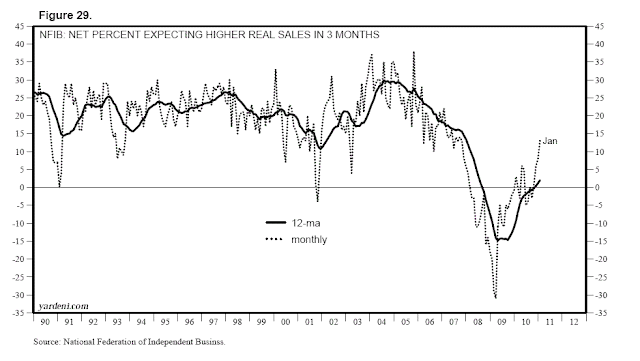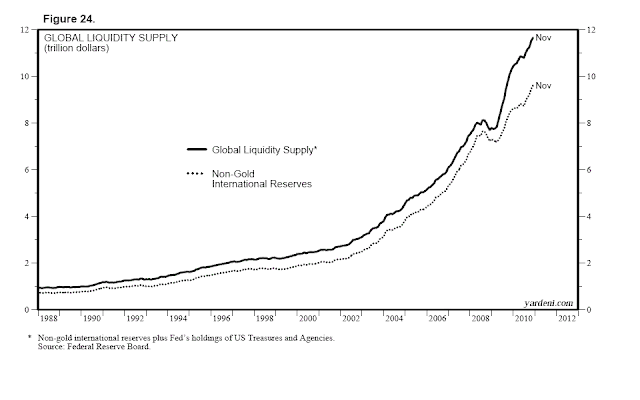Monday, February 28, 2011
Wednesday, February 23, 2011
Global Oil Bill
 |
The global oil bill soared to a record $4,252bn (annualized) during June 2008. It then plunged to $1,256bn during December 2008. That drop of $2,996bn was unprecedented and undoubtedly was one of the reasons why the global economy recovered so quickly over the past two years. The oil bill rebounded 149% back to $3,125bn during January 2011 from the 2009 trough. The good news is that global oil usage has increased nearly 3mbd over this period, reflecting the recovery in global economic activity. The 190% increase in the price of oil over this period also reflects the recovery, but it is also cutting into consumers’ purchasing power. The recent spike in the oil price is more troubling since it reflects possible supply disruptions. We update this chart regularly for subscribers in Analyst's Handbook: Energy. |
Tuesday, February 22, 2011
S&P 500 Forward Earnings
 |
Forward earnings rose again in February to a 31-month high after falling for nine straight months through May 2009. It rose 1.2% m/m in December and is just 4.6% below the record high in October 2007. Consensus annual earnings for 2011 and 2012 rose in February. Analysts expect earnings to rise 14.0% in 2011 and 14.1% in 2012 after surging 40.3% in 2010. We update this chart regularly for subscribers in Earnings Month (with Squiggles). |
 |
The forward P/E for the S&P 500 rose to a 10-month high of 13.5 in February from 13.1 in January. It is up from an 18-month low of 12.0 in August. |
Gasoline Price & Leading Indicators
 |
According to the Philly Fed’s monthly survey, the region’s manufacturing sector continues to expand at a fast pace. The current activity index increased for the fifth time in six months, climbing from -5.6 in August to +35.9 this month, the best reading since January 2004. The new orders index was little changed at 23.7 in February. The shipments index rose for the fifth straight month, jumping 21.8 points in February. The employment index increased for the second straight month from 4.3 to 23.5, the highest since April 1973. The ISM composite index is highly correlated with the 3-ma in the Philly Fed current activity index, which suggests robust manufacturing activity at the national level. We update these charts regularly for subscribers in US Business Surveys. |
Wednesday, February 16, 2011
Crude Oil
China's Currency
Monday, February 14, 2011
Consumer Sentiment
Sunday, February 13, 2011
Transportation Stock Indexes
 |
The Dow Jones Transportation Average (DJTA) rose last week to a cyclical high. Dow Theory technicians are most bullish when a rising DJIA is confirmed by its DJTA cousin. |
The S&P 500 Transportation Index rose to another record high at the end of the week. It was led by another record high for the Railroads industry. |
Wednesday, February 9, 2011
Small Business Survey
Tuesday, February 8, 2011
Fundamental Stock Market Indicator
 |
Is our Fundamental Stock Market Indicator (FSMI) still a good coincident indicator for the S&P 500? We think so. Our FSMI is the average of the Weekly Consumer Comfort Index (WCCI) and our Boom-Bust Barometer (BBB). It gained 2.0% during the final week of January, recovering two-thirds of the loss the prior two weeks. Before the recent decline, it had increased 21 out of 23 weeks. The FSMI is back within 1.2% of its recent high for the cycle. The BBB, which is the ratio of the CRB raw industrials spot price index to the 4-week average of jobless claims, has driven the move up in the FSMI, though it has been in a volatile flat trend in recent weeks as the 4-wa in jobless claims moved steadily higher since the start of the year. Meanwhile, the CRB raw industrials spot price index remains on its vertical ascent. The WCCI plunged 5 points during the first week of February, erasing all the improvement in the early weeks of this year. |
Monday, February 7, 2011
Expected Inflation
Sunday, February 6, 2011
Global Liquidity
 |
The holdings of US Treasuries and Agencies by all central banks rose to a record $5.59tn last week, up 82.3% over the past two years. |
Thursday, February 3, 2011
Raw Materials Prices
Tuesday, February 1, 2011
Purchasing Managers Surveys
 |
UK manufacturing activity outpaced US activity for the third straight month, though both accelerated sharply in January. |
 |
German PMI plunged along with the Ifo business expectations index in 2008. Both rebounded during 2009, and continued to climb in 2010. The Ifo index is at a high for the series going back to 1991. |
Grain Prices
Subscribe to:
Posts (Atom)



















